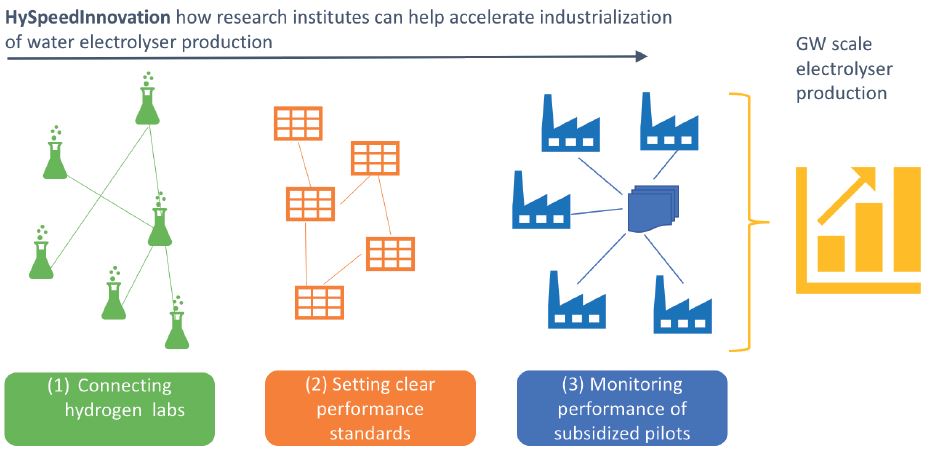European Research Institutions present Joint Action Plan to accelerate Development of Electrolysis
Industrialization of water electrolysis (WE) technologies is considered a critical step for the large-scale implementation of clean hydrogen and deep-decarbonization of our society. While Europe is strongly positioned to capture the economic value of the growing markets associated with clean hydrogen production, the timeline set by the energy transition requires a more coordinated effort. With the »HySpeedInnovation Joint Action Plan«, a number of leading European Research and Technology (RTO) institutes describe the upscaling challenges that lie ahead and how they can tackle these challenges in order to make Europe a leader in the field of electrolysis. The RTOs (TNO, Fraunhofer ISE, Fraunhofer IFAM, Forschungszentrum Jülich, SINTEF and CEA) also recommend a supporting role for the European Commission and national authorities. Other knowledge institutions from EU Member States have also embraced the call, as has the network Hydrogen Europe Research, which represents several hundred companies and organizations in the field of hydrogen.
Significant upscaling of production capacity
An enormous challenge lies ahead in upscaling currently available technologies to GW-scale factories required to drive forward the energy transition. For Europe, this challenge is reflected in the European Green Deal, which puts renewable hydrogen produced by electrolysis high on the political agenda. The European Hydrogen Strategy sets a target for 6 GW installed electrolyser capacity by 2024, and 2x40 GW by 2030 (40 GW in Europe and 40 GW in neighboring countries) producing respectively 1 and 10 million tons of hydrogen annually. Tens of billions of euros are promised as a stimulus for this development. Several hydrogen strategies from European member states also have quantified targets for electrolysers according to their National Hydrogen Strategies looking at 2030 horizon, e.g. 6.5 GW in France, 5 GW in Germany, 3-4 GW in the Netherlands, 1 GW in Portugal and 4 GW in Spain.
Fragmented knowledge and facilities
The researchers describe the advantages and disadvantages of the main technologies on which current electrolysers are based and where improvements are needed. This involves a good balance between cost, performance and sustainability. For example, a serious alternative has to be found for the scarce raw materials and rare metals currently used in electrolysers. The production method, still largely manual, can and must also become much more efficient and cheaper.
The most important obstacle to overcome is not so much technical: the chain of manufacturers, their suppliers and the knowledge institutions themselves is fragmented across Europe, thus slowing down the innovations needed to develop a new generation of electrolysers. There is also a lack of sufficient demand for green hydrogen, partly because the costs are still too high. This makes the business case for large-scale application dependent on government incentives.
Working together intensively
To support and accelerate the required developments, the European RTOs propose to work together more intensively and in a more coordinated way. For this purpose, three sets of opportunities have been identified: connecting hydrogen labs, setting clear performance standards and monitoring performance of subsidized pilots. For each opportunity, actions have been identified that fall within the responsibilities of Europe’s RTOs.
To achieve these objectives, European RTOs call for support from national governments and EU policy makers on the following topics:
- An EU funded program aimed at facilitating the establishment of a coordinated EU infrastructure enabling to use and share water electrolysis testing facilities, with the aim to support (new) industries and to facilitate easier access to the production chain.
- An EU funded program aimed at developing harmonized performance, safety, sustainability and quality standards setting international minimum requirements for (components of) electrolysers, e.g. as materialized in tender specifications.
- The implementation of an Open Access policy for sharing aggregated data and learnings. Governments should make sharing of data and learnings of all subsidized research, demonstration and deployment projects mandatory.
However, for each opportunity, some requirements will have to be met that lie outside of direct RTO influence. It is here that the responsibility of policy makers on the national and EU levels is required to facilitate the proposed effort.
Last modified:
